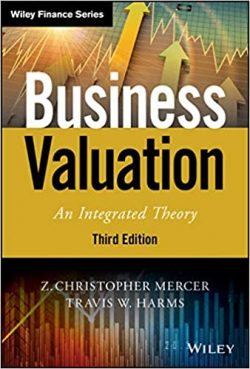Chris Mercer and Travis Harms’ newest book, Business Valuation: An Integrated Theory, Third Edition (John Wiley & Sons, Inc.), is now available for purchase on Amazon and Wiley.com. This revised and updated book explores the core concepts of the integrated theory of business valuation and adapts the theory to reflect how the market for private business actually works. The authors, two experts on the topic of business valuation, help readers translate valuation theory into everyday valuation practice.
Introduction
Mercer and Harms use the term integrated theory to refer to their rather dogged insistence that the key to answering thorny valuation questions is devoting one’s attention to cash flow, risk, and growth. Simply put, they propose that any valuation question (or problem, or controversy, depending on your perspective) is ultimately answerable by analyzing expected cash flows, risk, or growth expectations.
In this book, the authors provide readers with both the conceptual basis for – and practical application of – the Integrated Theory, which can be summarized as follows:
The value of any business or business ownership interest is a function of the expected cash flows attributable to the that business or business ownership interests, the expected growth in those cash flows over the relevant holding period, and the risks associated with achieving those expected cash flows.
The Integrated Theory provides a conceptual framework for a disciplined analysis of valuation questions. Too often, valuation analysts are tempted to view individual components of a valuation assignment on a piecemeal basis. Adhering to the Integrated Theory helps valuation analysts develop base valuation conclusions, discounts, and premiums that are rooted in a shared perspective of the subject company and the subject ownership interest.
What’s New in the Third Edition?
In the decade or so since the second edition of this book, valuation analysts have increasingly recognized the importance of evaluating private operating businesses from the perspective of the enterprise (equity plus net debt) rather than restricting the focus of analysis to the net equity of the business. The Integrated Theory is readily extended to the enterprise value perspective, and the authors demonstrate that extension in this edition.
Further, recognizing the need for more practical guidance regarding the application of the integrated theory to the valuation of enterprise value, they have added new chapters on estimating enterprise cash flows and developing enterprise discount rates. This third edition also includes new chapters relating the market and income approaches, using the Integrated Theory to expose the common conceptual underpinnings of the two approaches. Finally, Mercer and Harms have added a new chapter dedicating to dissecting the often cited, but less often understood, restricted stock and pre-IPO studies using the Integrated Theory as their scalpel.
The twelve chapters in this edition are organized into three sections.
Section 1 :: The Integrated Theory
- Chapter 1 – The World of Value.
- Chapter 2 – The Integrated Theory (Equity Basis).
- Chapter 3 – The Integrated Theory (Enterprise Basis).
Section 2 :: Using the Integrated Theory to Develop Firmwide Indications of Value
Each of the chapters in Section 2 is new to the Third Edition.
- Chapter 4 – Income Approach (Cash Flows).
- Chapter 5 – Income Approach (Discount Rate).
- Chapter 6 – Market Approach (Guideline Public Companies).
- Chapter 7 – Market Approach (Guideline Transactions).
Section 3 :: Using the Integrated Theory to Value Nonmarketable Minority Interests
- Chapter 8 – Restricted Stock Discounts and Pre-IPO Studies.
- Chapter 9 – Introduction to the QMDM (Quantitative Marketability Discount Model).
- Chapter 10 – The QMDM Assumptions in Detail.
- Chapter 11 – Applying the QMDM.
- Chapter 12 – Applying the Integrated Theory to Tax Pass-Through Entities.
Who Should Read This Book?
A variety of business valuation, legal, and accounting professionals and students should read Business Valuation: An Integrated Theory Third Edition.
Valuation Analysts (Business Appraisers)
The Integrated Theory provides the foundation for a deeper understanding of business valuation concepts. These insights will be helpful for beginning and experienced appraisers alike. In this book, the authors use the term valuation analyst to be synonymous with the standard definition of a business appraiser.
In addition, the Integrated Theory raises (and answers) a number of questions about “standard” valuation practices employed by many appraisers, including the application of control premiums, minority interest discounts, and marketability discounts.
Auditors and Financial Statement Users Considering Fair Value Measurements
The prominent role of fair value measurements in generally accepted accounting principles means that auditors need to be fluent in fundamental valuation principles. While the Integrated Theory does not address specific fair value measurement applications, it does provide assistance to CPAs and appraisers as they both attempt to translate interpretations of the concept from the FASB, the SEC, or elsewhere into reliable valuation techniques.
Familiarity with basic valuation principles and techniques is also beneficial for financial analysts and others who regularly review financial statements. To be an informed reader of financial statements, it is critical that one be able to evaluate not just the “what” but also the “why” of fair value measurements. The Integrated Theory provides a unique introduction to these issues.
Users of Business Appraisal Reports
The Integrated Theory will also be helpful for users of appraisal reports, including accountants, financial planners, and attorneys. The basic concepts of the Integrated Theory are not difficult, and the limited use of symbolic math is fairly easy to follow. The authors have advised clients for many years: “If you don’t understand it, then don’t stand for it.” The Integrated Theory, particularly when consulted on a specific-topic basis when questions arise, can help readers develop a better understanding of business valuation reports.
Corporate Finance and Valuation Students
Finally, Mercer and Harms believe that the Integrated Theory is an ideal teaching tool for students in accounting, finance, and economics. Valuation courses are increasingly common in business and economics programs at both the graduate and undergraduate levels. The Integrated Theory provides a concise, thorough, and logically consistent framework for introducing students to valuation theory and practice.
Testimonials
Mercer and Harms’ Business Valuation: An Integrated Theory, Third Edition provides valuation professionals, attorneys, other users of valuations, and students of valuation a resource for better understanding how the pieces of the valuation puzzle fit together. This book is written in an easy to follow style and is worthy of being added to your valuation library. – Roger J. Grabowski, FASA, Managing Director, Duff & Phelps
It has been 13 years since the second edition of this book came out. It was certainly worth the wait. All the core chapters have been updated with easy-to-understand explanations of valuation concepts. Mercer and Harms have also added new chapters on the Income Approach (Cash Flows), the Income Approach (Discount Rate), the Market Approach (Guideline Public Companies), the Market Approach (Guideline Transactions), and Restricted Stock Discounts and Pre-IPO studies. This well-written book presents a thoughtful approach to business valuation. The bottom line is that this is a valuable resource that tackles controversial topics head on. – James R. Hitchner, CPA/ABV/CFF, ASA, Managing Director, Financial Valuation Advisors
To continue the conversation about the topics found in this book, visit Chris Mercer’s blog and subscribe to receive future updates.


